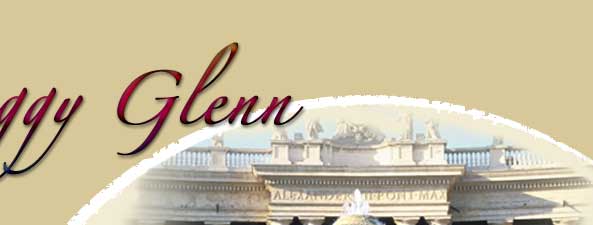|
|
|
The Colosseum |
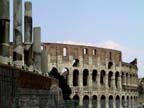 |
This is going to be a history lesson, therefore I am going to show the best of the pictures Sharon and I took, which will not correspond to the paragraphs, with the exception of when I am describing the building. (Sharon averages 220 pictures per day, I average 145, so we have a lot of pictures to look at each night! I try to show you the ones that demonstrate the most, as my webmaster would have a fit if I tried to upload too many!)
|
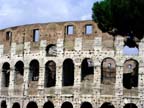 |
The Flavian Amphitheater is commonly called the Colosseum. Construction was started by Vespasian in 71 AD and finished by Titus in 80 AD with a solemn inauguration lasting 100 days. Some 5,000 wild animals were put to death during the inauguration. As a gigantic monument to the gladiatorial spectacles that were extremely popular in the Roman world and directed to praising the generosity of the emperors, the Colosseum was a huge success. |
 |
The name Amphiteatrum-Colyseus appeared for the first time in the 11 century. It derives from the colossal bronze statue of Nero (more than 90 feet high) that was located outside of the west side of the building. (The statue no longer exists.)
|
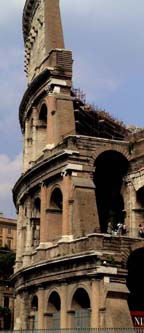 |
The building is divided into four levels for a total height of about 150 feet, and was constructed with square blocks of travertine. |
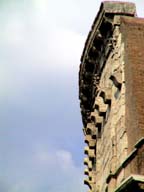 |
There was a large awning covering the entire building to protect the spectators from the sun and rain, which was pulled into place daily by a special unit of 237 sailors from the Imperial Fleet. The awning went up much like sail on a boat. The small blocks sticking out of the outside top of the Colosseum (shown in the photo) were used to tether the awning.
|
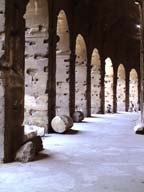 |
There are eighty arches on the outside which lead to 160 outlets on the inside.
|
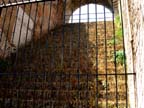
Steps to the seats.
|
The capacity was at least 73,000 spectators! Since the games were public spectacles, entering was free, but you needed a ticket. Your ticket had a seat assigned to it. There was a very complex system of passages and ramps which enabled the crowds to flow in and out with ease. It also ensured compliance with the seating arrangements which were strictly based on social standing.
|

The seats had roofs.
|
Apparently when Augustus had been upset by the insults that a senator received at games elsewhere, he had a senatorial decree issued providing that at every public performance, the front row of seats be reserved for senators. Soldiers were separated from civilians. Augustus assigned special seats to married commoners and a special section to boys not yet of age, as well as a section nearby for their tutors. He also banned badly dressed spectators from the best seats, and confined women to the highest rows, where they previously had been allowed to sit together with the men. Apparently, certain women however, of the oldest profession, were allowed to circulate with the senators. My how some thing never change!
|
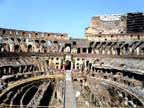 |
During the first 10 years, the middle of the Colosseum was empty of chambers. This allowed the floor to be flooded with at least 10 feet of water so naval battles with boats could be reenacted. During the 10th year, two stories of chambers were added to house the gladiators waiting to fight, as well as the convicts, wild animals and all the stage props. The chambers were covered by a wooden floor then topped with a bed of sand. |
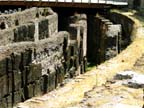 |
When the chambers were added, a very complex hoisting system which involved winches and counter weights was installed, becoming basically, the world's first elevator system. It is said at one point this system was used to bring 100 lions into the arena at the same moment. Their combined roar was so loud that the noisy crowd was frightened into instant silence. A tall wire mesh fence was installed around the floor of the arena to prevent the animals from escaping. Additionally, bowmen were placed throughout for added protection.
|
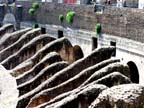 |
Gladiator & Animal Histories
The spectacles which took place were primarily of two kinds: gladiator fights and mock hunts of ferocious animals. These ended up involving both animals and people.
|
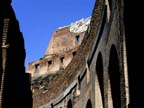 |
The first gladiator fight was in 264 BC organized for the occasion of the funeral of Brutus Pera by his sons. By the year 61 BC the games were entrusted exclusively to the emperors and promoted only on the occasion of public events and official inaugurations. The rule was that they had to be announced and sponsored by a promoter who after settling the price of the individual gladiators with their manager, saw to it that the program was well publicized far in advance.
|
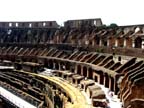 |
Being a gladiator was a profession. One obviously tried very hard not to be killed. In fact, most gladiators weren't killed as it was too expensive to find, train and house new ones. When one was obviously losing the fight or had already lost it, he asked for mercy from the promoter, or more often from the spectators. Mercy was usually given. Again, the promoter knew how to manage his money. A lot of the gladiator fights were prearranged just like today's TV wrestling.
|
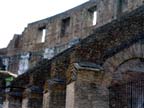 |
The gladiators entered the arena from the west entrance. Once the death of a gladiator had been verified with a poke from a red-hot iron, they were taken out by the east entrance.
|

A crown much like this one.
|
The winners were usually given palm branches and crowns, and sometimes prize money. Convicts whom had been sentenced to death were granted freedom.
|
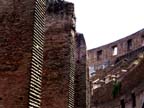 |
The animal hunts attempted to simulate real hunts, complete with stage props which mimicked the animal's environment. Stage managers of the Colosseum created hills, woods, and even small lakes. |
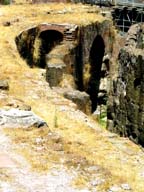 |
The first exotic animals to arrive in Rome were lions, panthers, leopards and hippopotamuses (they must have been a real pain to transport!). These hunts were big starting in 169 BC. In 55 BC a rhinoceros was brought to Rome by Pompey. In 46 BC a giraffe arrived.
|
 |
One kind of hunt involved the pursuit and capture of different kinds of ferocious animals. Another would be a fight to the death between two animals such as an elephant against a bull, or a rhinoceros against a bear. |
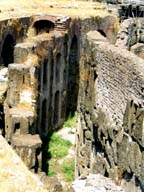 |
To celebrate the first ten years of rule by Septimius Severus, grand festivities and games were organized. According to Dio Cassius, "The entire cage in the amphitheater had the shape of a boat and could hold and release four hundred animals. And when suddenly opened, oxen, bears, lions, panthers and ostriches jumped out, so that seven hundred wild animals could be seen running all together with hunters in pursuit. The number of animals was seven times a hundred so that it would match the duration of the festivities, which lasted seven days."
Dios Cassius (155-235 AD) was a Roman historian who wrote over 80 books, 19 have survived in full.
|
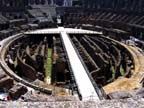 |
The emperors felt it was their responsibility to display their generosity by conceiving more and more lavish spectacles. Again, according to Dio Cassius, "Emperor Commodus killed one hundred bears by himself on the first day, shooting them from the podium railing. The amphitheater was divided into four sections so that they could be shot from all directions."
|
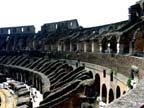 |
The practice of throwing deserters to the wild animals was begun by Scipio the Younger, around the middle of the 2nd century BC. Remember, the Colosseum was completed in 80 AD, so human death by animals had been around for three centuries. The first Christian to die as a martyr in the Colosseum was St. Ignatius, Bishop of Antiochia when he was thrown to the lions in the 2nd century AD.
|
 |
The last organized game in the Colosseum was in 523 AD under Theodoric, King of the Ostrogoths. It consisted only of animal hunts, for gladiator fighting had eventually been banned in 438 AD by the Christian emperors |

Braces were added in the 19th & 20th centuries.
|
Centuries of Decay
The ending of the games led to centuries of decay. In the 12th century the Frangipane family used it as their fortress up to around the middle of the 13th century.
|
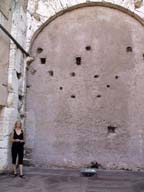
The walls are very high!
|
Meanwhile, systematic plunder had already begun with the blocks of travertine, the marble facing and everything that could be reused, including the metal clamps and pins that in antiquity held the block of stone together.
|
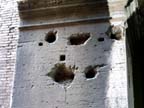 |
The large round holes that are still visible today, were caused by the removal of the iron. The smaller square holes were caused by the removal of the marble slabs.
|
 |
In the 15th century despite the efforts of Roman conservationists, excavation activity actually increased due to the building of St Peter's. The Church later turned the arena into a holy place: from the 16th century it housed a chapel and from 1720 along the outside, the Stations of the Cross.
|
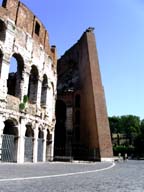 |
During the 19th century the first real excavations were started. Between 1805 and 1807 Raffaele Stern built the brick abutment in the east section.
|
 |
When you look at our pictures, the original walls are anywhere you see holes in them. The renovated sections have no holes. |
|
|
|
|
|
|
|
|

